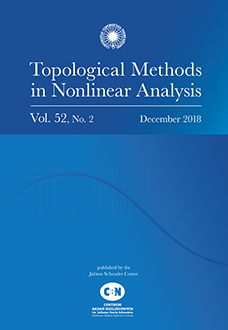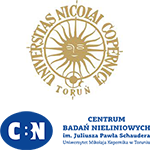Abstract
In the paper we give a generalization of the Filippov-Ważewski Theorem to the second order differential inclusions \begin{equation} \mathcal{D}y=y^{\prime \prime }-A^{2}y\in F( t,y) , \tag{$*$} \end{equation} with the initial conditions \begin{equation} y( 0) =\alpha ,\quad y^{\prime }( 0) =\beta , \tag{$**$} \end{equation} where $A\in \mathbb{R}^{d\times d}$ and $F\colon [ 0,T] \times \mathbb{R}^{d}\leadsto c( \mathbb{R}^{d}) $ is a multifunction satisfying for each $t\in [ 0,T] $ the Lipschitz condition in $y$ \begin{equation*} d_{H}( F( t,y_{1}) ,F( t,y_{2}) ) \leq l( t) \vert y_{1}-y_{2}\vert , \end{equation*} where $l(\,\cdot\,) $ is integrable. The main result is the following:
Theorem 5.1. Assume that $F\colon[ 0,T] \times \mathbb{R} ^{d}\leadsto c( \mathbb{R}^{d}) $ is measurable in $t$, Lipschitz continuous in $x\in \mathbb{R}^{d}$ $($with integrable constant$)$ and integrably bounded. Let $r\in W^{2,1}$ be a solution of the relaxed problem \begin{equation} \mathcal{D}y=y^{\prime \prime }-A^{2}y\in {\rm cl}\, {\rm co}\,F ( t,y) , \tag{$**$$*$} \end{equation} with $(**)$. Then, for each $\varepsilon \gt 0$, there exists a solution $y\in W^{2,1}$ of $(*)$ with $(**)$ such that \begin{equation*} \Vert y-r\Vert _{C^{1}[ 0,T] } \lt \varepsilon . \end{equation*}
The proof goes via a version of the Fillipov Lemma (Theorem 4.4) for inclusions ($*$).
Citation
Grzegorz Bartuzel. Andrzej Fryszkowski. "Filippov-Ważewski theorem for certain second order differential inclusions." Topol. Methods Nonlinear Anal. 47 (1) 389 - 403, 2016. https://doi.org/10.12775/TMNA.2016.013
Information





